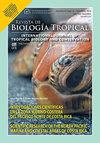Characteristics and spatial identification of Antillean manatee (Trichechus manatus manatus Sirenia: Trichechidae) strandings in Guatemala
IF 0.6
4区 生物学
Q4 BIOLOGY
引用次数: 0
Abstract
Introduction: Marine mammal strandings can be used to determine the impacts of anthropogenic activity on the species survival, population health, and levels of environmental pollution in ecosystems. In addition, these data can help design conservation and management strategies as well as identify priority areas for the species. The West Indian manatee (Trichechus manatus) is listed as endangered throughout its range. In Guatemala, it is distributed along the Caribbean coast. Anthropogenic activities appear to be having a direct pressure on the species, affecting the status of the population. Objective: The general purpose of this study was to analyze the 30 years of documented manatee stranding reports available for Guatemala. Two specific objectives were defined to: 1) conduct a spatial analysis of manatee strandings to identify the areas of high stranding concentration, and 2) determine whether there were sex differences in the number of strandings. Methods: Characteristics and areas of concentration of manatee strandings were described along the Caribbean coast between 1992 to 2022. Sites with the highest probable density of strandings were identified using a Kernel density analysis. We compared the number of stranding events that occurred in each protected area that included manatees in their management plans and each municipality of Izabal. We determined whether there were sex differences in the number of stranded manatees. We use the potential biological removal to estimate the maximum number of manatees that can be removed from the population due to anthropogenic causes without negatively impacting species survival. Results: Forty-three manatee stranding events were recorded throughout the species’ range in Guatemala (48 total individuals). The sites with the highest predicted density of strandings were Santo Tomás de Castilla bay, followed by Lake Izabal (including the limits of the Refugio de Vida Silvestre Bocas del Polochic) and Parque Nacional Río Dulce. The majority of the cases were registered in protected areas (60 %). Estimates of potential biological removal were equivalent to less than one manatee per year, which was exceeded by the annual average of stranded manatees recorded (three manatees). Conclusions: Anthropogenic activities cause mortality of manatees in this region, despite the implementation of protected areas. Poaching was identified as the main cause of manatee mortality in Guatemala. The implementation of management strategies focused on minimizing threats to the species, based on the application of environmental legislation and environmental awareness, is essential. The creation and implementation of a protocol for the stranding of marine mammals on the Caribbean coast of Guatemala is necessary, in order to obtain standardized records of these events and conduct rescue efforts and releases when possible.危地马拉安的列斯海牛(trichecchus manatus manatus Sirenia: Trichechus manatus Sirenia)搁浅特征及空间识别
海洋哺乳动物搁浅可用于确定人为活动对物种生存、种群健康和生态系统环境污染水平的影响。此外,这些数据可以帮助设计保护和管理策略,以及确定该物种的优先区域。西印度海牛(Trichechus manatus)在其分布范围内被列为濒危物种。在危地马拉,它分布在加勒比海沿岸。人类活动似乎对该物种产生了直接的压力,影响了种群的状况。
目的:本研究的一般目的是分析危地马拉30年来记录在案的海牛搁浅报告。确定了两个具体目标:1)进行海牛搁浅的空间分析,以确定搁浅高集中的区域;2)确定搁浅数量是否存在性别差异。
方法:对1992年至2022年加勒比海沿岸海牛搁浅的特征和集中区域进行了描述。利用核密度分析确定了最高可能链结密度的位点。我们比较了在每个将海牛纳入其管理计划的保护区和伊萨巴尔市发生的搁浅事件的数量。我们确定搁浅海牛的数量是否存在性别差异。我们使用潜在的生物移除来估计由于人为原因可以从种群中移除的海牛的最大数量,而不会对物种生存产生负面影响。
结果:在危地马拉整个海牛分布范围内共记录了43起海牛搁浅事件(共48只)。预测搁浅密度最高的地点是Santo Tomás de Castilla湾,其次是Izabal湖(包括Refugio de Vida Silvestre Bocas del Polochic)和国家公园Río Dulce。大多数病例发生在保护区(60%)。估计潜在的生物清除相当于每年不到一头海牛,超过了记录的搁浅海牛的年平均值(三只海牛)。结论:尽管实施了保护区,但人为活动导致了该地区海牛的死亡。偷猎被确定为危地马拉海牛死亡的主要原因。在实施环境立法和提高环境意识的基础上,执行侧重于尽量减少对该物种的威胁的管理战略是至关重要的。必须制定和执行一项关于在危地马拉加勒比海岸搁浅海洋哺乳动物的议定书,以便获得这些事件的标准化记录,并在可能的情况下进行救援工作和释放。
本文章由计算机程序翻译,如有差异,请以英文原文为准。
求助全文
约1分钟内获得全文
求助全文
来源期刊

Revista De Biologia Tropical
生物-生物学
CiteScore
1.80
自引率
0.00%
发文量
23
审稿时长
4-8 weeks
期刊介绍:
The Revista de Biología Tropical / International Journal of Tropical Biology and Conservation is a mainstream scientific journal published since 1953 and covered by Web of Science; Science Citation Index; Current Contents; Google Scholar; Scopus, SciELO and nearly 50 additional indices.
A double blind system guarantees you a fair evaluation, and our world class editorial and scientific boards provides a first decision in three working days. The journal is Full Open Access and is widely read where your article can have the highest real impact.
Since its beginning in 1953, the Revista follows these principles: objective and independent evaluation of all manuscripts; transparency in all processes; ethical use of procedures, data, specimens and subjects; fair treatment of all parties; and absolute predominance of scientific rigor over any other aspect.
 求助内容:
求助内容: 应助结果提醒方式:
应助结果提醒方式:


